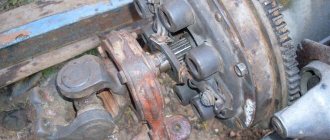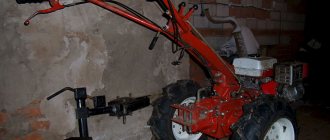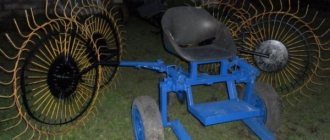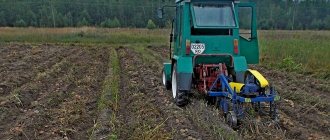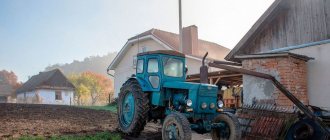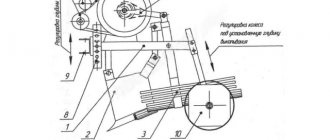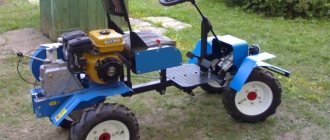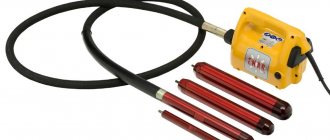Without high-quality clutch operation, full operation of the walk-behind tractor is impossible. The clutch is an essential component of the transmission, the function of which is to transmit torque from the crankshaft to change gears and disconnect the gearbox from the power plant during gear changes. The clutch of the walk-behind tractor is necessary for its smooth starting and stopping without the need to turn off the engine.
You can make the clutch for a walk-behind tractor yourself
Clutch device
With all the variety of brands of walk-behind tractors, their classes and modifications, the clutch device always includes several necessary parts:
- control unit;
- leading component;
- driven components.
The control unit includes direct control release levers connected to the pressure plate using rods and a lift equipped with a pedal. When the operator turns off the device, power is transmitted from the pedal to the levers using a tap equipped with a bearing. When the springs are compressed, the levers associated with the pressure plate move it away from the driven one, which causes the clutch to disengage.
The presence of a bearing in the design is designed to minimize the friction factor, since the lift and the levers do not touch. The standard design has three levers that are mounted relative to each other at an angle of 120 degrees. The presence of springs ensures that the device parts return to their original position. The offset shifts by the distance required to disengage the mechanism, and compliance with it is very important: if the required distance cannot be achieved, this leads to the clutch slipping and the friction linings being subjected to increased load and premature wear. Moreover, if the distance, on the contrary, is exceeded, the clutch does not completely disengage.
In this video you will learn how to change the clutch:
The driving component consists of the end of the engine flywheel and the pressure plate that simultaneously rotates with it. At the same time, the disk moves along the axis relative to it. Between these two components is another disk, the hub of which is located on a splined shaft. This is the driven part of the device. Around the drive plate there are cylindrical springs that have pre-compression and are necessary to press the pressure plate. This is achieved due to the fact that one end rests against the disk, and the other is located on the casing located on the driven surface. It is this design that ensures that the device is always on, even in the absence of movement and the engine is not turned off.
Enabling the device to stop generates a signal transmission to the release levers and simultaneous disabling of the driven part, due to which the clutch is disengaged.
Typically, the clutch design of small agricultural machinery units contains a bearing necessary to reduce friction. Its presence ensures smooth movement of the levers with the exception of their contact with each other. The device also contains a spring, which ensures that the control element returns to its original position after switching speeds.
Purpose and varieties
The clutch carries out inertial transmission of torque from the crankshaft to the transmission gearbox, ensures a smooth start of movement and gear shifting, and regulates the contact of the gearbox with the motor of the walk-behind tractor. If we consider the design features, the clutch mechanisms can be divided into:
- friction;
- hydraulic;
- electromagnetic;
- centrifugal;
- single, double or multi-disc;
- belt
Based on the operating environment, a distinction is made between wet (in an oil bath) and dry mechanisms. According to the switching mode, a permanently closed and non-permanently closed device is divided. Depending on how the torque is transmitted - one flow or two, one- and two-flow systems are distinguished. The design of any clutch mechanism includes the following elements:
- control node;
- leading parts;
- driven components.
The friction clutch is the most popular among farmers who own walk-behind tractors, because it is easy to maintain, highly efficient and lasts for a long period of continuous operation. The principle of operation is the use of friction forces that arise between the contacting edges of the driven and driving parts. The driving components work in rigid connection with the engine crankshaft, and the driven components work with the main shaft of the gearbox or (if it is absent) with the next transmission unit. The elements of the friction system are usually flat discs, but some models of walk-behind tractors have a different shape - shoe or cone.
In a hydraulic system, the moment of motion is transmitted through a fluid, the pressure on which is provided by a piston. The piston returns to its original position using springs. In the electromagnetic type of clutch, a different principle is implemented - the movement of the system elements occurs under the influence of electromagnetism forces.
This type is permanently open. The centrifugal clutch type is used in gearboxes that automatically change gears. Not very common due to rapid wear of parts and long duration of slipping. The disk type, regardless of the number of disks, is based on one principle. It is reliable and ensures smooth startup/shutdown of the unit.
Belt clutches are characterized by low reliability, low efficiency and rapid wear, especially when used with high-power motors.
Functions of the centrifugal clutch
There are several types of mechanism, but the most interesting in the context of the operation of household agricultural units is the centrifugal clutch for a walk-behind tractor - it is this kind of automatic clutch that is used in the power systems of walk-behind tractors and cultivators.
The operation of this type of device is based on a friction clutch. The functions of a centrifugal clutch for a walk-behind tractor include such important tasks as:
- stable torque transmission;
- reduction of vibrations resulting from the movement of parts of the structure;
- smoothness in gear shifting;
- the ability to connect gears without impact;
- turning the gearbox on and off;
- disconnecting the transmission from the flywheel.
The presence of a clutch allows the crankshaft to be temporarily disconnected. An engine equipped with this device starts and stops without sudden movements.
This mechanism performs one of the main functions
Size options
Clutch Ø133 mm
Installed on the crankshaft of four-stroke internal combustion engines:
— power up to 8 l/s (inclusive);
— idle shaft speed — 1800 rpm;
— actuation moment — 2000-2200 rpm;
— shaft diameter 19.05 and 20 mm.
Clutch Ø160 mm
Installed on the crankshaft of four-stroke internal combustion engines:
— power up to 15 l/s (inclusive);
— idle shaft speed — 1400 rpm;
— actuation moment — 1600-1800 rpm;
— shaft diameter from 25.0 to 25.4 mm.
Clutch Ø160 mm
Installed on the shaft of the reduction gear (internal combustion engine factory equipped):
— power up to 15 l/s (inclusive);
— idle speed at the output of the gearbox shaft is 700 rpm;
Principle of operation
The centrifugal clutch has undeniable advantages such as reliability and long service life. This design is used in automatic transmissions. This device consists of a standard set of components:
- flywheel;
- pulley;
- a hub equipped with a stopper groove and a key;
- flange;
- sleeve;
- casing;
- bearing;
- retaining ring.
Due to the connection of the differential with the centrifugal clutch, control of the unit is facilitated, its maneuverability and smooth turns are improved. In addition, the differential regulates the speed of rotation of the wheels and participates in their blocking. Some models of walk-behind tractors use special blockers that allow you to stop one wheel independently of the other.
Modern units can be equipped with mechanisms of various designs. There are several types of these mechanisms:
- frictional - easy to maintain and capable of working for a long time without pauses with high efficiency;
- centrifugal - has the disadvantage of rapid wear of parts of industrial mechanisms;
- belt - does not have high reliability and performance, quickly breaks down on powerful power plants;
- hydraulic - by pressing the pedal, it sets into motion a piston, the rotation of which imparts movement to the lubricating fluid; the force is transmitted from the piston to the connecting rod, and the springs return it to its original position;
- disk - characterized by high reliability of parts and smooth start-up; There are single-disc and multi-disc mechanisms that operate on the same principle.
Homemade centrifugal clutch
For one reason or another, it may be necessary to assemble a homemade clutch for a walk-behind tractor. This task is quite real, but before you begin, you need to understand the features of the device.
The principle of operation of any type of clutch is the continuous friction of its components. And this naturally leads to parts wearing out and the device becoming unusable. Undoubtedly, the easiest way out in this situation is to buy a new mechanism, but the main disadvantage of this solution is its cost. The finished part is quite expensive, and this is the main reason why many owners of walk-behind tractors make the clutch for the walk-behind tractor with their own hands.
Karakat from a walk-behind tractor
A fairly simple caracat with an engine from a Neva walk-behind tractor. In fact, this is a tractor, since it was planned to also cultivate the land on it. But I also wanted to ride off-road, so tube wheels were made. The caracat was not tested for buoyancy, but most likely it does not float as it is not small and the wheels are small. Wheels from some kind of cart from agricultural machinery. The speed is low and there are two standard gears of the walk-behind tractor gearbox. But in deep snow, although it is difficult, it goes. Until the snow cover overcomes up to 50cm. The second gear is more for knurled roads and hard ground.
Making a clutch mechanism with your own hands
Assembly of the device is preceded by two necessary steps: studying the drawings and selecting parts. The drawing should be as clear as possible, and all components indicated on it should have full size markings and indications of their places in the device.
To make a homemade mechanism, you need the following parts:
- input shaft and flywheel (for example, the corresponding parts from the Moskvich gearbox of previous decades are suitable);
- driven pulley (two handles must be installed on it at the preliminary stage of selecting parts);
- a working hub and a rotating metal knuckle (the best option is from a Tavria car);
- B-profile;
- crankshaft from a GAZ-69 car.
After the set of necessary parts is formed, assembly begins. The order of steps is as follows:
- Carefully grind the shaft so that after processing it does not come into contact with other parts that will be installed on the device.
- Install the walk-behind tractor hub onto the prepared shaft.
- Determine the location on the shaft where the bearings will be installed. Grind these places. After completing this stage of work, the hub should fit exactly, there should be no gaps, and the driven pulley should rotate easily, without touching anything.
- Drill six holes of equal diameter no more than 5 mm in the pulley at equal distances from each other. A 10mm long bolt will be installed in each hole, which requires holes on the other side of the pulley as well.
- Using a bolt, secure the pulley above the flywheel. Mark the holes that should coincide with the holes in the pulley.
- Remove the pulley and make holes according to the markings.
- Process the shaft and flywheel in such a way that after grooving they do not touch.
- Make a walk-behind tractor clutch handle. To do this, you can take a pipe 3 cm long and 1 cm in diameter. As a result of assembly, you will need to fix it on a pulley.
- Prepare the clutch cable for the walk-behind tractor. For this part, you can buy a suitable cord and wind it on a reel. As an option, you can use a clutch cable for a walk-behind tractor, made from a chainsaw cable that has a working reel.
A ready-made clutch made for a walk-behind tractor with your own hands is well suited, for example, for the Argo and Neva MB-2 walk-behind tractors.
Users note that this mechanism is of good quality and quite durable. This is interesting: a trailer hitch for a walk-behind tractor.
Product replacement
Changing this device is the most expensive process by financial standards. Although it is not necessary to change all components, experts recommend doing this at the same time. Let's look at how the procedure is performed:
- First of all, parts are purchased.
- Next, you need to completely dismantle the old product.
- All clamps are completely removed and the tension cable is removed.
- After this, you need to clean the landing site.
- Next, the new parts are assembled into a single mechanism.
- The device is mounted on the seat.
- The tensioner is connected to the release bearing through a spring.
- The entire structure is fixed using fasteners.
At first glance, there is nothing complicated about this, but the process is complicated by the fact that it is necessary to remove the clamps, which also partially hold the transmission.
Important! Experts recommend replacing the entire device based on practice, since over time the parts wear in and grind down, which makes it quite difficult to combine the new disk and the old basket, or vice versa.
Adjustment
For the mechanism to function properly, it is important that it is adjusted correctly. If a particular part is not operational, this is noticeable by characteristic signs and is adjusted in accordance with them:
- if the unit breaks away when the clutch is fully depressed, the adjustment is made using an adjusting bolt, which needs to be tightened;
- if the operator has completely released the clutch, but the intended speed is not achieved or the walk-behind tractor does not move at all, the adjusting bolt should be loosened;
- if the operation of the unit is accompanied by an uncharacteristic sound, it is necessary to turn off the engine and check the oil level; if there is enough oil, it is advisable to contact a service center;
- If difficulties arise when changing gears, you should check the condition of the shaft splines and gearbox parts.
Tags: tractors, case, do, constant, shaft, gearbox, belt, disconnect, most, crankshaft, used, smoothly, further, dependency, leading, first, contacts, force, or, workers, main, some, mounted, application, landing, applies, flat, average, regulates, beginning, looks, technical, different, electromagnetic, simplicity, based, role, environment, pedal, inconsistent, closed, wet, quantity, power, avoid, go, mark, mini tractor, search, Problems
